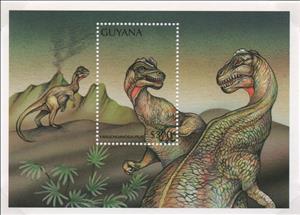Souvenir Sheet: Yangchuanosaurus (Guyana 1998)
Yangchuanosaurus (Guyana 1998)
23 February (Guyana ) within release Prehistoric Animals goes into circulation Souvenir Sheet Yangchuanosaurus face value 300 Guyanese dollar
| Souvenir Sheet Yangchuanosaurus in catalogues | |
|---|---|
| Stanley Gibbons: | Sg: GY MS5199a |
Souvenir Sheet is horizontal format.
Also in the issue Prehistoric Animals:
- Mini Sheet - 9 Dinosaurs face value 9*55;
- Stamp - Ceresiosaurus face value 55;
- Stamp - Coelacanth face value 55;
- Stamp - Grendelius face value 55;
- Stamp - Herrerasaurus face value 100;
- Stamp - Iguanodon face value 200;
- Stamp - Kentrosaurus face value 25;
- Stamp - Lagosuchus face value 60;
- Stamp - Lesothosaurus face value 30;
- Stamp - Mesosaurus face value 55;
- Stamp - Mixosaurus face value 55;
- Stamp - Northosaurus face value 55;
- Stamp - Placodus face value 55;
- Stamp - Rhomaleosaurus face value 55;
- Stamp - Stegoceras face value 35;
- Stamp - Stethacanthus face value 55;
- Souvenir Sheet - Styracosaurus face value 300;
- Souvenir Sheet - Yangchuanosaurus face value 300;
Souvenir Sheet Yangchuanosaurus it reflects the thematic directions:
Animals are multicellular, eukaryotic organisms of the kingdom Animalia (also called Metazoa). All animals are motile, meaning they can move spontaneously and independently, at some point in their lives. Their body plan eventually becomes fixed as they develop, although some undergo a process of metamorphosis later on in their lives. All animals are heterotrophs: they must ingest other organisms or their products for sustenance.
Dinosaurs are a diverse group of reptiles of the clade Dinosauria. They first appeared during the Triassic period, between 243 and 233.23 million years ago (mya), although the exact origin and timing of the evolution of dinosaurs is a subject of active research. They became the dominant terrestrial vertebrates after the Triassic–Jurassic extinction event 201.3 mya and their dominance continued throughout the Jurassic and Cretaceous periods. The fossil record shows that birds are feathered dinosaurs, having evolved from earlier theropods during the Late Jurassic epoch, and are the only dinosaur lineage known to have survived the Cretaceous–Paleogene extinction event approximately 66 mya. Dinosaurs can therefore be divided into avian dinosaurs—birds—and the extinct non-avian dinosaurs, which are all dinosaurs other than birds.
Reptiles are tetrapod (four-limbed vertebrate) animals in the class Reptilia, comprising today's turtles, crocodilians, snakes, amphisbaenians, lizards, tuatara, and their extinct relatives. The study of these traditional reptile orders, historically combined with that of modern amphibians, is called herpetology. Because some reptiles are more closely related to birds than they are to other reptiles (e.g., crocodiles are more closely related to birds than they are to lizards), the traditional groups of "reptiles" listed above do not together constitute a monophyletic grouping (or clade). For this reason, many modern scientists prefer to consider the birds part of Reptilia as well, thereby making Reptilia a monophyletic class.



